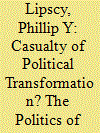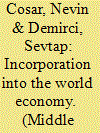| Srl | Item |
| 1 |
ID:
117077


|
|
|
|
|
| Publication |
2012.
|
| Summary/Abstract |
The Democratic Party of Japan (DPJ) came to power in 2009 promising significant transportation sector reform, but it has struggled to implement its proposals. I argue that the DPJ's initiatives faltered due to the legacy of "efficiency clientelism." Historically, Japanese transportation policy combined two imperatives: (1) encourage efficiency by raising the cost of energy-inefficient transportation, and (2) redistribute benefits to supporters of the incumbent Liberal Democratic Party (LDP). Because of the legacy of efficiency clientelism, DPJ campaign pledges-designed to appeal broadly to the general public by reducing transportation costs- ran up against the prospect of sharp declines in revenues and energy efficiency. Efficiency clientelism was well suited to political realities in Japan prior to the 1990s, but recent developments have undercut its viability. This raises profound questions about the sustainability of Japan's energy efficiency achievements.
|
|
|
|
|
|
|
|
|
|
|
|
|
|
|
|
| 2 |
ID:
086709


|
|
|
|
|
| Publication |
2009.
|
| Summary/Abstract |
The impact of globalization on the Ottoman Empire and modern Turkey was first observed broadly in the railways of the transportation sector in the 1850s, and eventually shifted towards highways by the 1950s. This change profoundly affected the structure of the economy, ultimately leading to its integration into the global system. In this article, we look at three questions: what was the role of railways in the Ottoman Empire from the 1850s to 1914? What were the characteristics of modern Turkey's railway policies following the War of Independence? And, finally, how did transport policies shift from railways to highways following the Second World War? The Ottoman railway network held special importance for the Empire's economic integration into world markets. Foreign capital was invested in railways to provide crucial links between production areas and harbours with the goal of facilitating the export of raw materials and agricultural goods with the government's financial support. Until the proclamation of the Republic in 1923, the rail network was unbalanced and lines were unconnected, damaging both the economic unity and integration of the Ottoman economy. Forming a nation state on the basis of a national economy was the primary goal of Republican government. As such, all of the early Republican governments continued building and funding the rail network despite problems allocating sufficient financial resources and pressing needs for social (i.e. a lack of health and education services) and economic development. After the Second World War, following liberalization in economic and political life and an infusion of foreign aid (heavily invested in agriculture and road transportation networks), Turkey saw its economy grow. With this economic expansion, modern Turkey began to shift the focus of its transportation policies from railways to highways. As demand increased and highway investments skyrocketed, a highly developed road transport network began to take shape in Turkey, ultimately at the expense of the railway system.
|
|
|
|
|
|
|
|
|
|
|
|
|
|
|
|